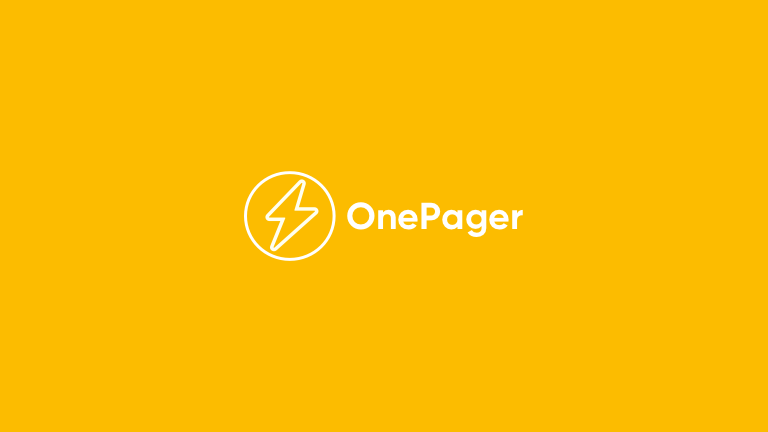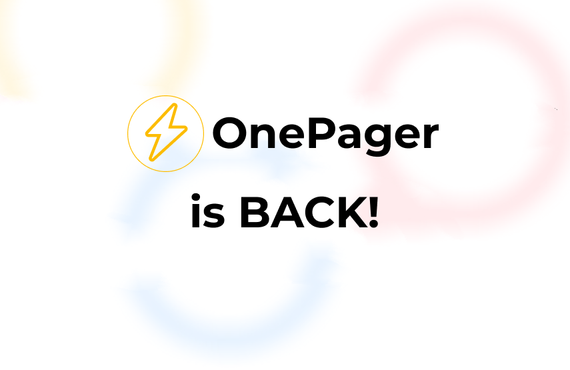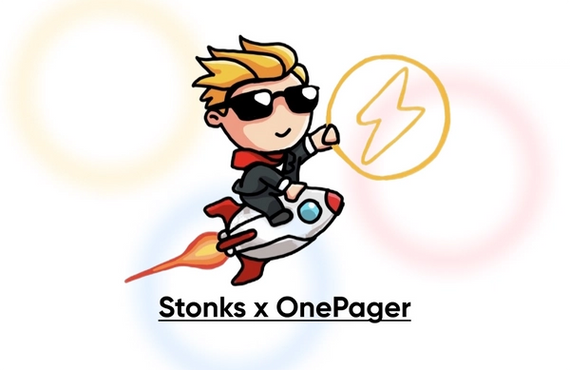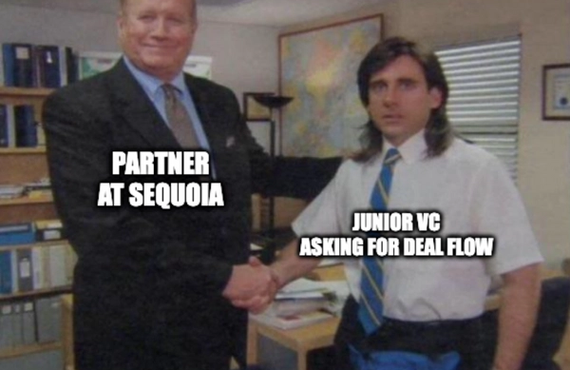The Past, Present, and Future of OnePager

Adam Hardej
Prev. OnePager Co-Founder
July 31st, 2021

Hi Everyone,
We really appreciate you taking the time to click in here and read a bit about what we’ve been up to. To our users who have been with us from the beginning — THANK YOU — none of this would be possible without your feedback and patience. If you’re new to OnePager — WELCOME — we’re incredibly proud to have you using our software and will always do everything we can to make it the best experience possible.
A quick table of contents for the casual reader who’s still deciding whether or not to dive in:
- Some context on OnePager and how we got here.
- OnePager user survey results and how we’re thinking about them.
- What to expect from us: short-term, medium-term, and long-term.
- A thank you for reading and for your continued support.
Past
It’s been an incredible journey so far, but it’s not where we originally thought we’d end up. When we first set out, we thought we should build a two-sided network with founders on one side and investors on the other. We hoped to succeed where AngelList had failed and fulfill the promise of a Match.com for early-stage fundraising. We still think that’s a worthy goal, but as we went deeper we came to some insights that pushed us in a different direction:
- The world is already full of giant networks that we all participate in every day. These networks have their own gravity that pulls in people and attention.
- Founders don’t need others to do things for them; they need better tools available to them so they can do things themselves.
- There are two ways to increase your likelihood of success in matchmaking: better guesses or more attempts.
- A pitch to an investor is only one of the three core pitches a founder makes and arguably the least important. Pitches to early-stage hires and early clients are the other two.
We were lucky that these realizations didn’t require us to double back on our efforts. We were already working with a lot of amazing founders and connecting them with the network of investors we had put together. When we did decide to change course it was a 45 degree turn rather than the dreaded 180.
So we set out again. This time, to build a tool for founders and attempt to translate our insights into product goals:
- Make it something founders can share with the networks they’re already a part of.
- Make it a tool, not a service, so that founders can push forward at their own pace.
- Make it digestible so that visitors can engage and gauge interest quickly.
- Make it customizable so it can be used by different founders for different use cases.
We called it OnePager, a tool for founders to consolidate and share their startup’s information. With OnePager, founders can bring together their company overview, team info, pitch deck, demo video, FAQs, and more under an easily shared URL with privacy settings and analytics built in. OnePagers are used by founders for sharing new projects, fundraising, sales, and recruiting.
Present
Now — 9 months after first launching on Product Hunt — we’re proud to have had thousands of founders use OnePager. Founders from top level programs like YC, On Deck, and Techstars. Founders we admire. One of the best parts of working on OnePager is how many awesome teams we get to interact with.
As exciting as it has been — we don’t think OnePager is anywhere close to perfect and, in a lot of ways, we don’t even think we’ve really gotten started. With that being the case, we’re constantly watching how OnePager is being used and asking OnePager users about their experience. As we mature as a team, we’re also always looking to improve internal systems and move away from anecdotal feedback.
At this point, our team has cumulatively read this “How Superhuman Built an Engine to Find Product/Market Fit’’ article ~50 times and we recently committed to the process. Honestly surveying your users can be a bit scary at first, but we ripped the bandaid off and have collected over 170 responses.
We followed the starter steps outlined in the article and we’re excited about the initial results. Here’s a look at some of what we’re seeing so far and our reactions:
~45% of users said they first found OnePager through “a friend” or “another founder” and ~25% found us through an “accelerator/demo day” they were previously a part of.
It’s encouraging to see word-of-mouth referrals at that level before we implement an incentive-based invite program and we’re excited to be able to reward users and supercharge that behavior. On the accelerator/demo day side, we’ve always suspected that it would be a great distribution network and we’re excited to have the data to support a more concerted effort in working with these partners.
~40% of users said that “sharing [their] info on a single URL” was the main benefit they receive from OnePager and ~20% said “tracking engagement of my visitors”.
*Phew* ~ It would have been a tough pill to swallow if a large chunk of our users thought an ancillary feature was the main product benefit. What jumped out to us though is how heavily it skewed toward “single URL” with other options surrounding privacy, analytics, and live updates available. This is a great reminder for us to stay focused on the product vision for OnePager: a tool for founders to consolidate and share their startup’s information. It’s also interesting to see that early-stage businesses using OnePager have similar needs to comparable, but proven, products in the creator space, with companies like Linktree growing quickly.
~80% of users would be disappointed if they could no longer use OnePager.
Not a bad place to start! We’re still cutting up our user types and trying to better define our high expectation customers, but we’re happy to see that ~60% of users would be “somewhat disappointed” and ~20% would be “very disappointed” if OnePager was taken away. We’re in a similar place as Superhuman described starting their process which feels solid. That being said, the road to the 40% “very disappointed” target won’t be an easy one.
At the risk of being repetitive — we don’t think we’re more than an inch over the starting line here, but we are happy with the starting line itself.
Future
Following the PMF engine framework — from here we’re excited to dig in with our “somewhat disappointed” users to see what we can do to push them into the “very disappointed” category. We will continue to periodically survey users to make sure we’re on the right track, but for now — we’re more motivated than ever to push forward.
In the short-term, we have a couple changes on the way that should make the current product more accessible and enjoyable:
We will be dropping the price of OnePager Pro from $49/mo to $14/mo.
This is a big step and — as you can tell by the size of the change — we were a ways off the first time. After a lot of survey questions and follow-up interviews, we think our core mistake here was the difference between the product we asked users about in our original pricing surveys and the product as it stands today. As we continue to offer OnePager Pro, we want to reiterate that there will always be a free version of OnePager and we will look to consistently improve the free product offering as well.
The new and improved OnePager marketing website is on the way.
This is long overdue and will be a nice facelift in general. More importantly, it will better explain things like feature breakdown based on plan type and core use cases. Up to this point, we’ve been able to be very hands-on with users as they’ve explored the tool, but as we’ve grown, our bandwidth is now stretched thin and the need for more self-serve resources becomes clear. The new site will also feature a blog where we’ll dive deeper on commonly asked questions, best-practices, and success stories.
In the medium-term, the survey did a great job in highlighting places in the tool with the highest impact to lift ratio for us to focus on:
We’ve only scratched the surface with analytics.
Analytics has been and continues to be where users really feel the benefits of OnePager for the first time. Home to the “aha” moment as far as we can tell — but we haven’t changed it at all since we first launched. We’ve learned so much from when we first sketched out the analytics page and we can’t wait to put those learnings into action. We’ll be cleaning up some of the basic functionality first to make sure we’re building off of a strong base, but from there we’ll be looking to implement some core improvements like slide-by-slide engagement tracking, heatmaps, and better visitor history navigation.
In-product referrals and rewards.
With so many founders sharing their OnePagers with other founders and bringing them to the tool it’s only right to implement systems to reward that behavior. We want to make this easy and worth it for both sides so we’ll look to implement two-sided rewards. We’re also working on some fun giveaways for our biggest champions so stay tuned.
Our Boards tool and the accelerator use-case.
Boards is a secondary tool we built to help organizers bring together multiple OnePagers under a single URL. It has gotten rave reviews from programs like the Yale x Harvard Pitch Competition, GSV Startup Bootcamp, and Afore Capital’s Zero-to-One Demo Day. Despite the interest, we’ve been so focused on OnePager itself that we haven’t been able to do much more than maintain it. That’s going to change soon in a big way with added features for organizers to create multiple boards, invite multiple contributors, and — my personal favorite — create custom badges that will tag OnePagers included on that Board.
In the long-term, we will continue to listen to our users and look for new ways to help founders leverage their story to go further, faster:
One Link to Tell Your Startup’s Story.
The largest takeaway from the survey was a reinforced understanding of our core value proposition and we’re excited to further travel down that path. The OnePager Builder — where founders put their information together in the tool itself — hasn’t changed much since we first launched and we’re excited to get back to basics. The initial focus on revamping how a OnePager is built will be allowing users to reorganize the different cards of information, providing more flexibility in how they tell their story. Next, we will start building new cards to add to a OnePager, including an appendix with relevant links and files, a timeline for product development, and displaying verified data pulled from services like Stripe or Google Analytics, to name a few. This system will allow us to provide flexibility across different use cases while still making it easy for founders to put their best foot forward.
Navigation for an increasingly complex ecosystem.
There has never been a better time to be a founder, but it has also never been more overwhelming. New options pop up every day — from new investors looking to support companies in the earliest stages to new tools to build with. With so many options available it can be hard to see the right path forward. It’s our goal to help founders not only move through the ecosystem faster, but to move in the right direction. Things like guides on best-practices, suggested target investors, and special deals on best-in-class tools will be our first steps forward here. We believe we have an opportunity to help democratize building by making it easier for founders to understand what’s available and relevant.
Thank you
As many of you know, building products is both rewarding and arduous. It takes time to create quality products and, even when you’re moving fast, it never feels fast enough.
Being founders, building for other founders, has been an incredible experience. The support and the feedback we’ve received, as well as the amount we’ve learned and the people we’ve gotten to meet. We’re so thankful for the opportunity to build for people we love to work with.
Thank you for reading this far and, as always, if you ever have any questions please don’t hesitate to reach out.
Talk Soon,
The OnePager Team


